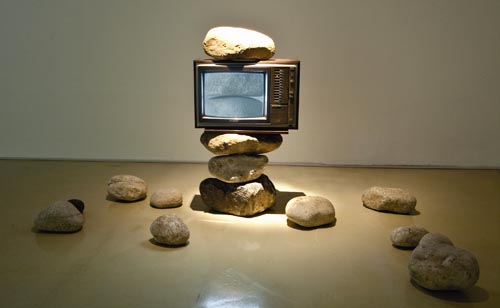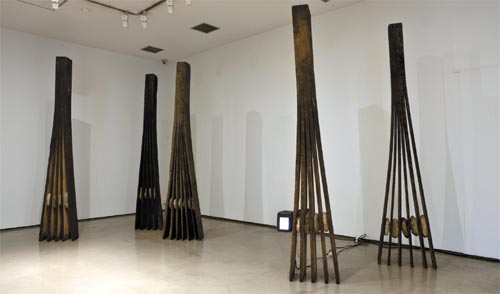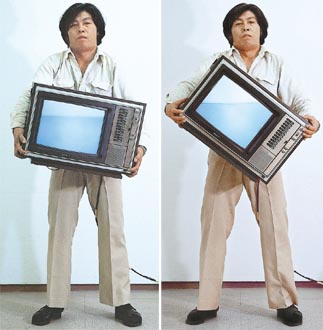Two minds between illusion and reality

“Video Stone Towers” (1978) by Park Hyun-ki. Provided by Gallery Hyundai
This is the work of Park Hyun-ki (1942-2000), shown at “The Pioneer of Korean Video Art Park Hyun-ki: A Retrospective,” an exhibition at Gallery Hyundai in the Samcheong-dong neighborhood in central Seoul.
It’s just one of the exhibitions running this month that are likely to excite fans of multimedia art.
The Park retrospective has already opened, and will continue until March 28. Another by the even more famous Paik Nam-june starts tomorrow at the Nam June Paik Art Center in Yongin, Gyeonggi.
Whereas Paik is familiar to art critics worldwide and to the Korean public, Park is known among only specialists.
“Before Park, nobody had tried to juxtapose real objects found in nature with the illusions of objects on a video monitor, which was a rare medium of art at that time [during the 1970s],” said Koh Hee-kyung, a manager at the gallery.
“He used stones in particular as ‘found objects,’ as stones have great meaning in philosophy and aesthetics in East Asia,” she continued. “It contributed to the history of modern Korean aesthetics. He also created many unprecedented experiments, so it is very regrettable that the public is not familiar with him.”

“Untitled” (1993) by Park Hyun-ki.
At the 1979 event, Park held a performance titled “Inclining Water,” and a series of photos taken of that performance are part of the exhibit at Gallery Hyundai. In the photos, Park tilts a video monitor displaying an image of water tilting in turn, giving the illusion that the television is full of water.
Unfortunately, at that time Korea was gripped by political and social turbulence, and art, especially the emerging field of video art, was a distant luxury they could not afford. Moreover, Park worked and held exhibitions mainly in Daegu, his hometown, instead of Seoul, where it would have been easier for him to attract public attention. In 2000, just as the Korean public’s interest in art began to develop at last, Park passed away from cancer. This is why Park is less well known here, Gallery Hyundai explained.
“The public’s acceptance of video art as a vital form of artistic expression has spread over recent years as the regularly held media art biennale promoted [media art] as the country’s technology saw dramatic advances,” Kang Tae-hi, professor at Korea National University of Arts, wrote in a paper for the exhibition. “However, study of the artist who initiated it all has not seen much progress.”
According to art critics, Park began to consider the possibility of working with television images when he first encountered the work of Paik Nam-june in the mid-1970s.
“We must be careful, however, not to over-emphasize the shadow of Paik’s influence on Hyun-ki Park’s work,” Kang wrote. “Park’s approach to video and technology rather resembles the growing interest in objects and material in Korean art of the ’70s, East Asian philosophies and the Japanese Mono-ha movement, which rejected Western modernism that focused on artist expression or intervention.
“He realized the technical limitations of his own experience in the field unlike Paik,” Kang wrote. “Consequently, he resolved to free his video work from technology and find his own vocabulary by the means of ‘low-technology.’”

These photos were taken of Park’s performance “Inclining Water” at the 1979 Sao Paulo Art Biennale. Provided by Gallery Hyundai
Sometimes they are juxtaposed with “real” objects, provoking questions about reality and illusion. One video looks down at the waves of the Nakdong River, with a mirror placed at the bottom reflecting the water’s surface. The footage runs on several TV monitors with delicately adjusted color tones, appearing like a series of abstract paintings.
It’s easy to see that Park’s works used different colors in the late 1990s, just before his death. In the “Blue Dining Table” series, videos of major political and social events in Korea’s modern history are projected onto giant plates, holding plaster casts of the artist’s body parts, sitting on a table. The “Mandala” series shows images from pornography projected onto the titular religious symbol, mixing ornate, abstract religious meaning with obscene, visceral video.
A visit to the Nam June Paik Art Center immediately after a walk through the Park retrospective shows just how different the two artists really were.
Whereas most of Park’s video art is contemplative, with still or slowly moving pictures surrounded by objects found in nature, Paik is much more theatrical and dynamic, using noisy and dazzling images.
Beginning tomorrow, the museum will introduce new arrivals, including “Video Chandelier” on its first floor, and will hold a special exhibition of artists inspired by Paik on the second floor. The new works will become part of the center’s permanent display, while the special exhibition will continue until May 9.
“We bought some important works by Paik last year,” the museum said in a statement. “They include his early-stage works, posters and documents from the 1950s and ’60s purchased from a German collector, the first of the ‘Video Chandelier’ series purchased from a German TV broadcasting station and others.”

“Video Chandelier No. 1” (1989) by Paik Nam-june.
“We have chosen these six works to let well-known and emerging contemporary artists find the social, political and aesthetic meanings of them,” the museum said in its statement.
The six pieces show Paik’s artistic sensibilities involved more than just the flickering, colorful piles of televisions for which he has become famous. Paik also embarked on completely different experiments.
For example, in the “Random Access” project, Paik let visitors compose their own electronic music by using a sound head detached from a tape recorder, which they could drag along strips of prerecorded audiotape tacked onto the wall. Paik had been considering the possibilities of combining music, performance and electronics since he met with the U.S. avant-garde composer John Cage in the late 1950s.
The participants in the special exhibition include both well-known artists such as the American video and installation artist Bruce Nauman and the Swiss installation artist Thomas Hirschhorn and emerging artists such as the Korean installation artist Yangachi.

“Hand and Face” (1961) by Paik Nam-june.
*The exhibit “The Pioneer of Korean Video Art Park Hyun-ki: A Retrospective” will continue until March 28 at the Gallery Hyundai in Samcheong-dong, central Seoul. Go to Anguk Station, line No. 3, exit 1. The gallery is open Tuesday through Sunday from 10 a.m. to 6 p.m. For more information, visit www.galleryhyundai.com.
The exhibit “Random Access” will start tomorrow and run though May 9 at the Nam June Paik Art Center. Take bus No. 5000 or 5005 from Euljiro 1-ga Station, line No. 2, to Yongin. The gallery is open Monday through Sunday 10 a.m. to 7 p.m. For more information, visit http://njp.kr/ie_eng.html.
By Moon So-young [symoon@joongang.co.kr]
Related Korean Article
갤러리현대서 10주기 박현기 회고전
물이 찬 TV 수상기를 힘겹게 들고 있는 이 남자를 보라. 1970년대식 장발에 꽉 다문 입 매무새가 결기 있어 보인다. 때는 79년 브라질 상파울루 비엔날레. 물이 담긴 영상이 있는 모니터를 들고 기울이는 각도에 따라 물의 기울기가 달라 보이는 상황을 연출한 그는 한국 비디오 아트의 선구자 박현기(1942~2000)다. 그는 말했다. “완전한 대상이 그물에 걸렸는가? 결코 그렇지 않다. 왜냐하면 우리가 잡았다고 생각하는 그 대상은 추상의 결집이지 대상 그 자체는 아니기 때문이다.”
비디오 아트의 창시자로 꼽히는 백남준(1932~2006)이 주로 외국에서 활동한 해외파였다면 박현기는 토종 국내파였다. 백남준이 “예술은 텃세다. 보편성이 아니다”라며 “황색 재앙! 그것이 바로 나다”라고 백인중심의 세계 미술계에서 전사처럼 싸울 때, 박현기는 변방에 앉아 고독한 싸움을 벌였다. 당시로선 현대미술의 후진국이었던 한국에 앉아서 오로지 생각 하나로 세계 머리에 올라앉는 기량을 보여준 작가다. 더구나 70년대라는 당시 한국 상황의 암울함을 헤아려보면 그의 외로운 분발은 놀랍다.
한글 기사 보기
갤러리현대서 10주기 박현기 회고전
물이 찬 TV 수상기를 힘겹게 들고 있는 이 남자를 보라. 1970년대식 장발에 꽉 다문 입 매무새가 결기 있어 보인다. 때는 79년 브라질 상파울루 비엔날레. 물이 담긴 영상이 있는 모니터를 들고 기울이는 각도에 따라 물의 기울기가 달라 보이는 상황을 연출한 그는 한국 비디오 아트의 선구자 박현기(1942~2000)다. 그는 말했다. “완전한 대상이 그물에 걸렸는가? 결코 그렇지 않다. 왜냐하면 우리가 잡았다고 생각하는 그 대상은 추상의 결집이지 대상 그 자체는 아니기 때문이다.”
비디오 아트의 창시자로 꼽히는 백남준(1932~2006)이 주로 외국에서 활동한 해외파였다면 박현기는 토종 국내파였다. 백남준이 “예술은 텃세다. 보편성이 아니다”라며 “황색 재앙! 그것이 바로 나다”라고 백인중심의 세계 미술계에서 전사처럼 싸울 때, 박현기는 변방에 앉아 고독한 싸움을 벌였다. 당시로선 현대미술의 후진국이었던 한국에 앉아서 오로지 생각 하나로 세계 머리에 올라앉는 기량을 보여준 작가다. 더구나 70년대라는 당시 한국 상황의 암울함을 헤아려보면 그의 외로운 분발은 놀랍다.










with the Korea JoongAng Daily
To write comments, please log in to one of the accounts.
Standards Board Policy (0/250자)